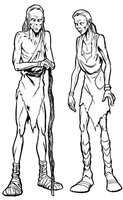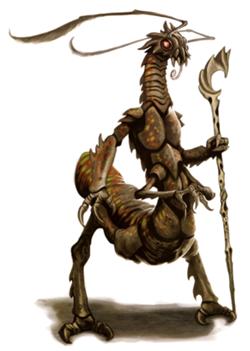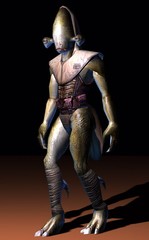Legends Galactic History 101: Formation of the Galaxy
1. Introduction
Welcome, students, to my classroom. The scope of this course is breathtaking: we will be covering the history of the galaxy from its formation until the creation of the Galactic Republic, a span of billions of years. Nearly all records from the pre-Republic era have long since vanished, but we've managed to piece together enough to give us some idea what these ancient beings and civilizations were like.
We here at the Shadow Academy are firm believers in learning from our collective shared histories, whether it's the history of our Orders, our races, our planets, or our entire galaxy - for it is through history that we learn not only where we've been but where we are going. As such, we encourage you to use this course as a stepping stone to greater understanding of the history of the galaxy and the events that have brought us all to today. To that end, there will be links throughout to further reading that might interest you after completion of the course. While you will not be tested on the further reading, you might find the information interesting.
2. Formation of the galaxy (13 Billion Years BBY - 200,000 BBY)
Most historians agree the galaxy was formed some thirteen billion years ago, with one of the first stars formed in the Cularin system. That star, Morasil, was later joined by a white dwarf star named Termadus to form the binary star system we know today. Over the next several billion years, new stars were formed and planetary systems created. This process slowed down five billion years ago with the formation of the Yavin system; around this time, xenobiologists believe life developed for the first time on Goroth Prime and would later appear in other worlds over the following four billion years. At this time, most of the Core and Rim stars had been created, though there were still new stars forming from time to time.
2.1 The Sharu

The earliest known civilization in the galaxy was created in the Rafa system by a race known as the Sharu sometime before 1,000,000 BBY. The Sharu created many technological wonders, including plastic pyramids and the Mindharp of the Sharu - a strange object that had the power to shift through dimensions. They are thought to have hidden their technological advances and lived primitively to escape the notice of the Celestials (who will be discussed later). The Sharu were thought extinct until recently (in 4 BBY) when Lando Calrissian stumbled upon the Mindharp and it was activated. This caused the Sharu to come out of hiding and again take up residence on their planet, which was quite an alarming event for the human inhabitants who had come to live on the planet almost a billion years after the Sharu vanished.
Further reading:
* Timeline of Galactic history
* Mindharp
2.2 The Zhell and the Taung

The Zhell and the Taung were two races native to the planet of Notron, the ancient name for the planet we now know as Coruscant. Most xenobiologists, in fact, consider the Zhell direct ancestors of the modern Human species, and have placed them on the planet around 200,000 BBY. The two species - the Zhell, organized in the thirteen nations known as the Battalions of Zhell, and the Taung, a clannish warrior society - were in a constant state of war for hundreds of years.
Sometime during this period, a volcano erupted on the surface of Notron with clouds of ash blocking out the sun. This devastated the tribes of the Zhell, causing them to reach near extinction, and the Taung were able to easily defeat the remnants. In honor of the event, the Taung adopted the name Dha Werda Verda (“Warriors of the Shadow”). The Zhell were able to eventually regroup and drove the Taung off Coruscant to the planet Roon, where they would form the race now known as Mandalorians.
Further reading:
* Shadow Academy course on Mandalorians
2.3 The Columi
The Columi were a technologically advanced species hailing from the planet Columus, known for its low gravity. They were among the first to utilize interstellar spacecraft, using ships in 100,000 BBY to survey numerous planets, including Coruscant. Among the species they observed were the Duros and Humans, but none were sophisticated enough by their standards to merit further exploration. Because of their frustration, they returned to Columus and became extremely isolated. Much like the Sharu, it is hypothesized that they hid the true nature of their technological advances so they would not appear on the proverbial radar of the Celestials.
Further reading:
* Columus
3. The Celestials (100,000 BBY - 35,000 BBY)

The Celestials were the first major system-spanning group in the galaxy, however, very little information about them exists; most of what we will discuss is conjecture based on xenoarchaeology and the records of races they subjugated. From what we can find, the Celestials were a race of aliens, also known as the Architects, famous for their huge constructions (many of which still exist). The Celestials also had the incredible ability to utilize their creations to move entire planets and systems and create hyperspace abnormalities (like the Maw). For example, the Corellian system was artificially created from pre-existing planets in other systems that the Celestials pulled together into new orbits.
As mentioned, one of the ways we have any information on the Celestials is a result of records left by the enslaved races and species they used as laborers. Many of the prominent early species - Humans, Sharu, Taung, and others - were spread like seeds across the galaxy where the Celestials would be working. One of the most famous of these enslaved species were the Killik, an insectoid species originally from Alderaan. These Killik were instrumental in the construction of the most famous piece of Celestial architecture, Centerpoint Station. It was this station that actually allowed the Celestials to move planets or even suns from across the galaxy through the use of incredibly powerful tractor beams.
However powerful they were, they were not immortal, and eventually one of the species the Celestials had spread throughout the galaxy as one of their enslaved species would be their downfall. We are speaking, of course, of the Rakata of the Infinite Empire.
Further reading:
* Centerpoint Station
* the Killik
4. The Infinite Empire (35,000 BBY - 25,200 BBY)

The Infinite Empire was the next major system-spanning group in the galaxy, formed after the Rakata overthrew their former masters, the Celestials. The Rakata, or Builders, were a race of amphibious humanoids that developed on the planet Rakata Prime. On their home planet (sometimes known as Lehon), the Rakata met the Kwa, an ancient alien species originally from Dathomir that were strong in the Force. The Kwa had developed technology they called the Infinity Gates which allowed almost instantaneous transport from one gate to the next. The Kwa taught the Rakata the power of the Force, but refused to share with them the secrets of these Infinity Gates. This refusal led, sometime before 35,000 BBY, to a battle on Rakata Prime between the Kwa and the Rakata which found the Rakata using their newfound knowledge of the Dark Side of the Force to achieve victory over their former teachers. However, before they were defeated, the Kwa were able to successfully destroy the Infinity Gates, denying their use to the Rakata.
The Rakata rose to prominence by developing unique technology that harnessed the power of the Force, especially the dark side. The Rakata are known to have created the earliest forms of energy shielding and, some believe, the first hyperdrives. These hyperdrives could only travel to planets visible in the Force, turning the Rakata into conquerors as they traveled to planets with a large life force.
At its peak, Rakatan civilization formed the Infinite Empire. Using their Dark Side-fueled technologies, the Rakata enslaved hundreds of developing species, including the Duros and Humans. Much like the Celestials before them, the Rakata are known to have inadvertently sown the seeds of life across the galaxy as they ferried enslaved species to other worlds. Notable species under the rule of the Infinite Empire were the Sith of Ziost, the Noghri of Honoghr, native Corellian species, the Wookiees of Kashyyyk, and the Selkath of Manaan.

It was during this time of expansion and enslavement that the Rakata created four enormous space stations/factories; the most famous of these were the Foundry and the Star Forge, the latter of which would later be used by Darth Revan and Darth Malak to create the vast Sith armies that battled the Old Republic following the Mandalorian War. The Star Forge was a great factory fueled by the Dark Side of the Force and the nearby Rakata star. Using the Force along with the heat, energy, and matter it pulled from this star, it was capable of creating virtually anything: starships, weapons, and droids to fill the Rakatan army.
After thousands of years of supremacy, the Infinite Empire began to crumble. The Star Forge was corrupting the minds of the Rakata as it was increasingly used as a conduit to channel the Dark Side of the Force. This influence caused the Rakata to wage a civil war upon themselves that lasted many years. Just as they were recovering from this war, the Rakata began to suffer from a deadly and rapidly-spreading plague.
The plague brought the Infinite Empire to its knees and killed untold millions of Rakata, but a worse fate awaited those who survived. The plague began to cause the Rakata to lose their connection to the Force and left them no clues as to why. Rakatan scientists worked feverishly to find a cure, but none were successful. The Rakata even began to believe the plague was created by an enslaved species since it only affected the Rakata and no other species.
As the amount of Rakata who could use the Force dwindled at an ever-increasing rate, they lost the ability to control their own technology and were forced to rely on less advanced devices that didn't depend on the Force. Sensing their masters weakness, the various enslaved species began to revolt. This led to the complete collapse of the Infinite Empire around 25,200 BBY.
After their empire collapsed, the Rakata retreated to Rakata Prime. No longer able to use the Force, they reverted to a barbaric and cruel society. Warlords fought for control and very nearly destroyed themselves. Eventually, the surface of the planet became so polluted and war-torn that Rakatan civilization was forced underground, with only the priest caste remaining on the surface to protect their ancient temples and safeguard the knowledge of their technology and history. In time, the Rakata were purposely erased from the records of those they enslaved, and the Infinite Empire faded into galactic history.
Further reading:
* Infinity Gate
* Star Forge
5. The Hutts and Xim the Despot (25,200 BBY - 25,100 BBY)
The Hutt Empire was an ancient empire with an unknown date of creation mainly based in the Outer Rim of the galaxy with a few scattered Mid-Rim territories. This empire was governed by a body known as the Clan of the Ancients, later known as the Hutt Grand Council, which ruled from the Si'Klaata Cluster. The Hutt Empire rose to power in the void between the collapse of the Infinite Empire and the rise of the Old Republic. While the Infinite Empire had ruled through domination and military might, and later the Old Republic would rule though political power, the Hutt Empire ruled through economics by controlling trade routes.

The Hutts came from the planet Varl in a binary solar system where they worshipped their twin suns, Evona and Ardos, as gods. Varl was a lush forest planet that was eventually destroyed. The Hutts claim the planet was destroyed when a black hole devoured Evona and Ardos then collapsed, but it is believed they destroyed the planet themselves with civil wars.
After the loss of Varl, the Hutts colonized a planet called Evocar and displaced the native people through uncanny business sense, eventually evicting them from their own planet. The Hutts renamed their new home Nal Hutta, meaning Glorious Jewel in Huttese. It would later become the capital of the Hutt Empire. Nal Hutta has a single moon, Nar Shaddaa, known as the Smuggler's Moon. Today, Nar Shaddaa is a well-known hub for scum and villainy.
Neighboring the Hutt Empire was the Tion Hegemony, ruled by a cruel and merciless human named Xim the Despot. Xim's father was a prince in the Hegemony and carved out his own Kingdom, which he called Cron from the Livien League which had previously ruled Tion. When he died, control of the Kingdom passed to Xim, who, unlike his father, was nothing more than a pirate and thug. Xim expanded his kingdom between 25,130 BBY and his death in 25,100 BBY. His most noted conquest was the present day Corporate Sector; many believe the lack of native life in the Sector upon its founding was due to Xim's practice of casting his enemies into space and the mass murder of entire populations.
Xim's decline began around 25,105 BBY when he set his eye on the riches of the Hutt Empire. Xim attacked the fleets of Kossak the Hutt, a major warlord of the Hutt Empire. The First Battle of Vontor was disastrous for Xim, as his entire fleet was destroyed by Kossak. Over the next five years, Xim and Kossak would trade victories as they fought for control of the Si'Klaata Cluster - an area in Hutt Space near the Tion Hegemony, known most famously as the “finish line” of the Kessel Run. Xim's last defeat came in 25,100 at the Third Battle of Vontor when Kossak and his allied conscripts completely destroyed Xim's fleet (again). Kossak had hired (or enslaved depending on the source) the other species in the Si'Klaata Cluster – the Nikta, Klatooinians, and the Vodran – and these combined were able to definitively defeat Xim, who died as a slave in Kossak’s palace some years later.
Following the victory, the Treaty of Vontor was signed between the Hutts, Nikto, Klatooinians, and Vodran, establishing the Hutts as overlords of the three species and eternal rulers of the Si'Klaata Cluster. Xim's demise led to the end of the Tion Hegemony, as after his passing it split into competing kingdoms that routinely warred.
Further reading:
* Nar Shaddaa
* Kessel Run
6. Rise of the Old Republic (25,053 BBY - 25,000 BBY)
Around fifty years after the Hutt Empire defeated Xim and signed the Treaty of Vontor, the Unification Wars hit the galaxy. Though very little is known about these Wars, one thing is certain: the direct result of peace was the signing of the Galactic Constitution in 25,053 BBY that formed the Galactic Republic, more commonly known as the Old Republic. Fifty-three years later, in 25,000 BBY, Humans and Duros were able to reverse-engineer the Infinite Empire technology to which they had been exposed and create the first hyperdrives that did not require the Force. With this latest invention, the fledgling Galactic Republic was able to expand its influence beyond Coruscant and the Core Founders - the term for the Core worlds that had come together to create the Constitution - into the Colonies Region, the Inner Rim, and beyond.
Further reading:
* Core Founder
7. Conclusion
And thus, with the creation of the Old Republic, we draw this whirlwind tour of the creation of our galaxy as we know it to a close. There has certainly been a lot of information covered, and it is our sincere hope you found it interesting and perhaps read deeper into the subject at a later date. Good luck as you continue on to the exam and, hopefully, the remainder of the courses in this series.
Information for this course was researched using:
* Wookieepedia
Please log in to take this course's exam